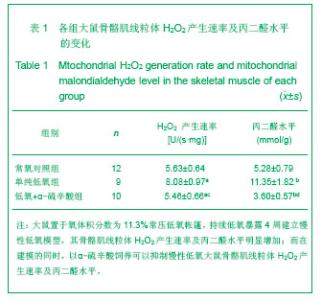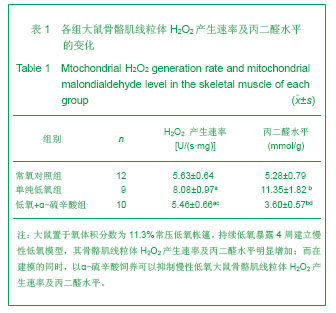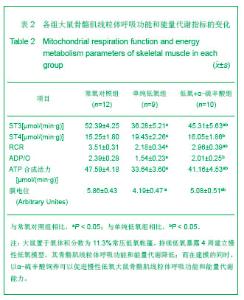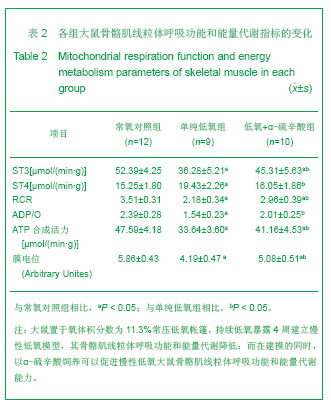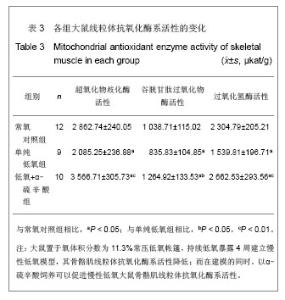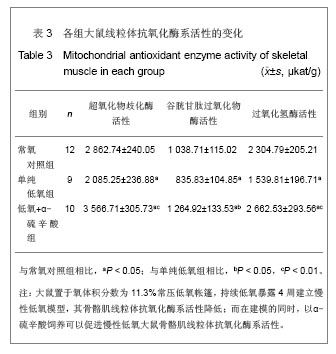Chinese Journal of Tissue Engineering Research ›› 2013, Vol. 17 ›› Issue (28): 5216-5222.doi: 10.3969/j.issn.2095-4344.2013.28.019
Previous Articles Next Articles
Alpha-lipoic acid inhibits mitochondrial oxidative stress in the rat skeletal muscle with chronic hypoxia exposure
Xiao Pin1, 2, Pang Yi-hui3, Peng Peng1, Bo Hai1
- 1Department of Military Training Medicine, Logistics University of Chinese People’s Armed Police Force, Tianjin 300162, China; 2Department of Pharmacy, Jiangxi Provincial Corps Hospital of Chinese People’s Armed Police Force, Nanchang 330001, Jiangxi Province, China;
3Department of Remote Education, Logistics University of Chinese People’s Armed Police Force, Tianjin 300162, China
-
Online:2013-07-09Published:2013-07-09 -
Contact:Bo Hai, M.D., Lecturer, Department of Military Training Medicine, Logistics University of Chinese People’s Armed Police Force, Tianjin 300162, China bohaixd@126.com -
About author:Xiao Pin, Department of Pharmacy, Jiangxi Provincial Corps Hospital of Chinese People’s Armed Police Force, Nanchang 330001, Jiangxi Province, China; Department of Pharmacy, Jiangxi Provincial Corps Hospital of Chinese People’s Armed Police Force, Nanchang 330001, Jiangxi Province, China zpchen_5500@126.com -
Supported by:Youth Foundation of Application Basis and Front Technology Research of Tianjin, No. 12JCQNJC07900*;
Science and Technology Research Foundation of Logistics University of Chinese People’s Armed Police Force, No. WYB201106*
CLC Number:
Cite this article
Xiao Pin, Pang Yi-hui, Peng Peng, Bo Hai. Alpha-lipoic acid inhibits mitochondrial oxidative stress in the rat skeletal muscle with chronic hypoxia exposure[J]. Chinese Journal of Tissue Engineering Research, 2013, 17(28): 5216-5222.
share this article
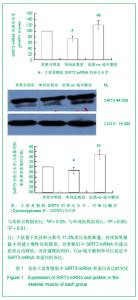
单纯低氧组大鼠骨骼肌线粒体ST3,RCR,ADP/O,ATP合成活力、膜电位显著低于常氧对照组 (P < 0.05),而大鼠骨骼肌线粒体ST4显著高于常氧对照组(P < 0.05)。与单纯低氧组比较,单纯低氧+α-硫辛酸组大鼠骨骼肌线粒体ST3,RCR,ADP/O,ATP合成活力、膜电位明显升高(P < 0.05),ST4显著降低 (P < 0.05)。 2.4 各组大鼠骨骼肌SIRT3 mRNA和蛋白表达的变化 单纯低氧组大鼠骨骼肌SIRT3 mRNA和蛋白表达均显著低于常氧对照组(P < 0.05)。与单纯低氧组比较,单纯低氧+α-硫辛酸组大鼠骨骼肌SIRT3 mRNA和蛋白表达明显升高(P < 0.05,P < 0.01),见图1。"
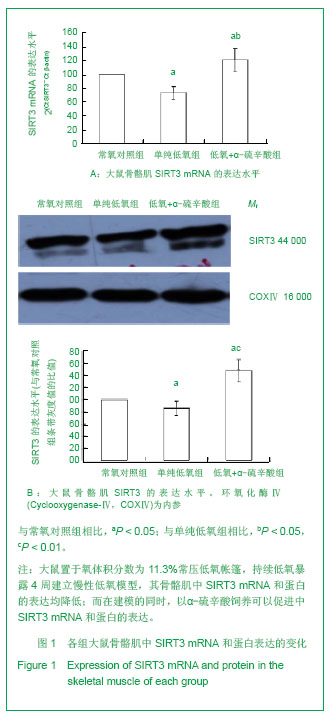
| [1]Lenihan CR, Taylor CT. The impact of hypoxia on cell death pathways. Biochem Soc Trans. 2013;41(2):657-663. [2]Luo Y, Lu G, Chen Y, et al. Long-term cycles of hypoxia and normoxia increase the contents of liver mitochondrial DNA in rats. Eur J Appl Physiol. 2013;113(1):223-232. [3]Jang MK, Son Y, Jung MH. ATF3 plays a role in adipocyte hypoxia-mediated mitochondria dysfunction in obesity. Biochem Biophys Res Commun. 2013;431(3):421-427.[4]Lundby C, Calbet JA, Robach P. The response of human skeletal muscle tissue to hypoxia. Cell Mol Life Sci. 2009; 66(22):3615-3623. [5]Levett DZ, Radford EJ, Menassa DA, et al. Acclimatization of skeletal muscle mitochondria to high-altitude hypoxia during an ascent of Everest. FASEB J. 2012;26(4):1431-1441. [6]Gamboa JL, Andrade FH. Muscle endurance and mitochondrial function after chronic normobaric hypoxia: contrast of respiratory and limb muscles. Pflugers Arch. 2012;463(2):327-338. [7]Pialoux V, Mounier R. Hypoxia-induced oxidative stress in health disorders. Oxid Med Cell Longev. 2012;2012:940121. [8]Venditti P, Di Stefano L, Di Meo S. Mitochondrial metabolism of reactive oxygen species. Mitochondrion. 2013;13(2):71-82. [9]Jezek P, Plecitá-Hlavatá L. Mitochondrial reticulum network dynamics in relation to oxidative stress, redox regulation, and hypoxia. Int J Biochem Cell Biol. 2009;41(10):1790-1804. [10]Solaini G, Baracca A, Lenaz G, et al. Hypoxia and mitochondrial oxidative metabolism. Biochim Biophys Acta. 2010;1797(6-7):1171-1177. [11]Cui H, Kong Y, Zhang H. Oxidative stress, mitochondrial dysfunction, and aging. J Signal Transduct. 2012;2012: 646354. [12]薄海,张红英,李海英,等.低氧复合运动通过NO-ATF1通路上调大鼠骨骼肌线粒体解偶联蛋白3表达[J].中国组织工程研究与临床康复,2010, 14(41):7643-7648.[13]Storm J, Müller S. Lipoic acid metabolism of Plasmodium--a suitable drug target. Curr Pharm Des. 2012;18(24): 3480-3489.[14]Gor?ca A, Huk-Kolega H, Piechota A, et al. Lipoic acid - biological activity and therapeutic potential. Pharmacol Rep. 2011;63(4):849-858.[15]薄海,张红英,李海英,等.低氧复合运动对大鼠骨骼肌解偶联蛋白3表达及线粒体功能的影响[J].中国康复医学杂志,2012, 27(1): 16-21. [16]Gupte AA, Bomhoff GL, Morris JK, et al. Lipoic acid increases heat shock protein expression and inhibits stress kinase activation to improve insulin signaling in skeletal muscle from high-fat-fed rats. J Appl Physiol. 2009;106(4):1425-1434.[17]Bo H, Wang YH, Li HY, et al. Endurance training attenuates the bioenergetics alterations of rat skeletal muscle mitochondria submitted to acute hypoxia: role of ROS and UCP3. Sheng Li Xue Bao. 2008;60(6):767-776.[18]Bo H, Jiang N, Ma G, et al. Regulation of mitochondrial uncoupling respiration during exercise in rat heart: role of reactive oxygen species (ROS) and uncoupling protein 2. Free Radic Biol Med. 2008;44(7):1373-1381. [19]Jiang N, Zhang G, Bo H, et al. Upregulation of uncoupling protein-3 in skeletal muscle during exercise: a potential antioxidant function. Free Radic Biol Med. 2009;46(2): 138-145. [20]Keil VC, Funke F, Zeug A, et al. Ratiometric high-resolution imaging of JC-1 fluorescence reveals the subcellular heterogeneity of astrocytic mitochondria. Pflugers Arch. 2011; 462(5):693-708. [21]侯伊玲,薄海,刘子泉,等.缺血预处理抑制大鼠胰腺移植缺血再灌注胰腺细胞凋亡:活性氧与线粒体DNA修复酶的作用[J].中国组织工程研究与临床康复,2010,14(18):3279-3285.[22]Souza AC, Ferreira RC, Gonçalves SS, et al. Accurate identification of Candida parapsilosis (sensu lato) by use of mitochondrial DNA and real-time PCR. J Clin Microbiol. 2012;50(7):2310-2314. [23]Jing E, Emanuelli B, Hirschey MD, et al. Sirtuin-3 (Sirt3) regulates skeletal muscle metabolism and insulin signaling via altered mitochondrial oxidation and reactive oxygen species production. Proc Natl Acad Sci U S A. 2011;108 (35):14608-14613.[24]Votion DM, Gnaiger E, Lemieux H, et al. Physical fitness and mitochondrial respiratory capacity in horse skeletal muscle. PLoS One. 2012;7(4):e34890. [25]Chen J, Gao Y, Liao W, et al. Hypoxia affects mitochondrial protein expression in rat skeletal muscle. OMICS. 2012; 16(3):98-104. [26]Waypa GB, Marks JD, Guzy RD, et al. Superoxide generated at mitochondrial complex III triggers acute responses to hypoxia in the pulmonary circulation. Am J Respir Crit Care Med. 2013;187(4):424-432. [27]Wang L, Wu CG, Fang CQ, et al. The protective effect of α-Lipoic acid on mitochondria in the kidney of diabetic rats. Int J Clin Exp Med. 2013;6(2):90-97. [28]Valdecantos MP, Pérez-Matute P, González-Muniesa P, et al. Lipoic acid administration prevents nonalcoholic steatosis linked to long-term high-fat feeding by modulating mitochondrial function. J Nutr Biochem. 2012;23(12): 1676-1684. [29]Padmalayam I. Targeting mitochondrial oxidative stress through lipoic acid synthase: a novel strategy to manage diabetic cardiovascular disease. Cardiovasc Hematol Agents Med Chem. 2012;10(3):223-233.[30]Deschermeier C, Hecht LS, Bach F, et al. Mitochondrial lipoic acid scavenging is essential for Plasmodium berghei liver stage development. Cell Microbiol. 2012;14(3):416-430.[31]Hebert AS, Dittenhafer-Reed KE, Yu W, et al. Calorie restriction and SIRT3 trigger global reprogramming of the mitochondrial protein acetylome. Mol Cell. 2013;49(1): 186-199. [32]Green MF, Hirschey MD. SIRT3 weighs heavily in the metabolic balance: a new role for SIRT3 in metabolic syndrome. J Gerontol A Biol Sci Med Sci. 2013;68(2):105-107. [33]Pellegrini L, Pucci B, Villanova L, et al. SIRT3 protects from hypoxia and staurosporine-mediated cell death by maintaining mitochondrial membrane potential and intracellular pH. Cell Death Differ. 2012;19(11):1815-1825. [34]Valdecantos MP, Pérez-Matute P, González-Muniesa P, et al. Lipoic acid improves mitochondrial function in nonalcoholic steatosis through the stimulation of sirtuin 1 and sirtuin 3. Obesity (Silver Spring). 2012;20(10):1974-1983. [35]Wagner AE, Ernst IM, Birringer M, et al. A combination of lipoic acid plus coenzyme Q10 induces PGC1α, a master switch of energy metabolism, improves stress response, and increases cellular glutathione levels in cultured C2C12 skeletal muscle cells. Oxid Med Cell Longev. 2012;2012: 835970. [36]Qiu X, Brown K, Hirschey MD, et al. Calorie restriction reduces oxidative stress by SIRT3-mediated SOD2 activation. Cell Metab. 2010;12(6):662-667. [37]Levett DZ, Radford EJ, Menassa DA, et al. Acclimatization of skeletal muscle mitochondria to high-altitude hypoxia during an ascent of Everest. FASEB J. 2012;26(4):1431-1441.[38]Wagner AE, Ernst IM, Birringer M, et al. A combination of lipoic acid plus coenzyme Q10 induces PGC1α, a master switch of energy metabolism, improves stress response, and increases cellular glutathione levels in cultured C2C12 skeletal muscle cells. Oxid Med Cell Longev. 2012;2012: 835970. [39]Bo H, Zhang Y, Ji LL. Redefining the role of mitochondria in exercise: a dynamic remodeling. Ann N Y Acad Sci. 2010; 1201:121-128. [40]Song W, Song Y, Kincaid B, et al. Mutant SOD1G93A triggers mitochondrial fragmentation in spinal cord motor neurons: neuroprotection by SIRT3 and PGC-1α. Neurobiol Dis. 2013; 51:72-81.[41]Haigis MC, Deng CX, Finley LW, et al. SIRT3 is a mitochondrial tumor suppressor: a scientific tale that connects aberrant cellular ROS, the Warburg effect, and carcinogenesis. Cancer Res. 2012;72(10):2468-2472. [42]Giralt A, Villarroya F. SIRT3, a pivotal actor in mitochondrial functions: metabolism, cell death and aging. Biochem J. 2012;444(1):1-10. [43]Giralt A, Hondares E, Villena JA, et al. Peroxisome proliferator-activated receptor-gamma coactivator-1alpha controls transcription of the Sirt3 gene, an essential component of the thermogenic brown adipocyte phenotype. J Biol Chem. 2011;286(19):16958-16966.[44]Kong X, Wang R, Xue Y, et al. Sirtuin 3, a new target of PGC-1alpha, plays an important role in the suppression of ROS and mitochondrial biogenesis. PLoS One. 2010;5(7):e11707. [45]Jacobs KM, Pennington JD, Bisht KS, et al. SIRT3 interacts with the daf-16 homolog FOXO3a in the mitochondria, as well as increases FOXO3a dependent gene expression. Int J Biol Sci. 2008;4(5):291-299.[46]Giusti S, Converso DP, Poderoso JJ, et al. Hypoxia induces complex I inhibition and ultrastructural damage by increasing mitochondrial nitric oxide in developing CNS. Eur J Neurosci. 2008;27(1):123-131. [47]Ahn BH, Kim HS, Song S, et al. A role for the mitochondrial deacetylase Sirt3 in regulating energy homeostasis. Proc Natl Acad Sci U S A. 2008;105(38):14447-14452. [48]Sack MN. The role of SIRT3 in mitochondrial homeostasis and cardiac adaptation to hypertrophy and aging. J Mol Cell Cardiol. 2012;52(3):520-525. [49]Kendrick AA, Choudhury M, Rahman SM, et al. Fatty liver is associated with reduced SIRT3 activity and mitochondrial protein hyperacetylation. Biochem J. 2011;433(3):505-514. [50]Iwahara T, Bonasio R, Narendra V, et al. SIRT3 functions in the nucleus in the control of stress-related gene expression. Mol Cell Biol. 2012;32(24):5022-5034. |
| [1] | Pei Lili, Sun Guicai, Wang Di. Salvianolic acid B inhibits oxidative damage of bone marrow mesenchymal stem cells and promotes differentiation into cardiomyocytes [J]. Chinese Journal of Tissue Engineering Research, 2021, 25(7): 1032-1036. |
| [2] | Li Cai, Zhao Ting, Tan Ge, Zheng Yulin, Zhang Ruonan, Wu Yan, Tang Junming. Platelet-derived growth factor-BB promotes proliferation, differentiation and migration of skeletal muscle myoblast [J]. Chinese Journal of Tissue Engineering Research, 2021, 25(7): 1050-1055. |
| [3] | Yu Langbo, Qing Mingsong, Zhao Chuntao, Peng Jiachen. Hot issues in clinical application of dynamic contrast-enhanced magnetic resonance imaging in orthopedics [J]. Chinese Journal of Tissue Engineering Research, 2021, 25(3): 449-455. |
| [4] | Luo Anyu, Liu Hanlin, Xie Xiaofei, Huang Chen. Effect of antioxidant mixture on structural degeneration of an osteoarthritis rat model [J]. Chinese Journal of Tissue Engineering Research, 2021, 25(23): 3625-3629. |
| [5] | Bai Shengchao, Gao Yang, Wang Bo, Li Junping, Wang Ruiyuan. Dynamic changes of mitochondrial function of the skeletal muscle after acupuncture intervention in rats with heavy load exercise-induced injury [J]. Chinese Journal of Tissue Engineering Research, 2021, 25(23): 3648-3653. |
| [6] | Yang Xinhua, Yan Yindi, Luo Xuguang, Yang Yanping, Li Hairong, Cui Huilin, Cao Ximei. Bmal1 and Clock regulate the development and differentiation of skeletal muscle [J]. Chinese Journal of Tissue Engineering Research, 2021, 25(20): 3130-3137. |
| [7] | Li Shang, Huang Xiang, Chen Ming, Lei Mingxing, Cheng Shi, Zhang Licheng, Yin Pengbin, Tang Peifu. Semaphorin 3A is expected to be a new target for the repair of skeletal muscle injury [J]. Chinese Journal of Tissue Engineering Research, 2021, 25(20): 3232-3238. |
| [8] | Liu Xing, Wei Xiaohan, Deng Jie, Li Zhongming . Preparing a blunt contusion model of rabbit skeletal muscle under different blow strengths [J]. Chinese Journal of Tissue Engineering Research, 2021, 25(2): 196-200. |
| [9] | Huang Xudong, Yi Zhiyong, Han Qingmin. Musculoaponeurotic manipulation changes contractile mechanics of the skeletal muscle in rabbits with knee osteoarthritis [J]. Chinese Journal of Tissue Engineering Research, 2021, 25(2): 201-204. |
| [10] | Cong Renyuan, Yuan Jing, Xia Jinchan, Sun Ying . Effects of baicalin on oxidative stress in BEAS-2B cells stimulated by lipopolysaccharide combined with adenosine triphosphate [J]. Chinese Journal of Tissue Engineering Research, 2021, 25(2): 286-291. |
| [11] | Li Lunyu, Jin Songlin, Huang Zenghao, Kang Liang, Hu Yushi, Ding Haili. Self-renewal and signal regulation of myosatellite cells: application hotspots and problems [J]. Chinese Journal of Tissue Engineering Research, 2021, 25(2): 304-310. |
| [12] | Chen Tiangui, Gao Lei, Li Tianbo, Wang Jiangning. Effects of Mailuoning Injection on mitochondrial autophagy and PINK1/Parkin pathway in a pig model of crush injury syndrome [J]. Chinese Journal of Tissue Engineering Research, 2021, 25(17): 2676-2680. |
| [13] | Zhou Yi, Chen Yueping, Zhang Xiaoyun, Lai Yu, Liao Jianzhao, Li Shibin. An exploration on mechanism of Shengyu Decoction in treating osteonecrosis of the femoral head based on network pharmacology [J]. Chinese Journal of Tissue Engineering Research, 2021, 25(17): 2687-2696. |
| [14] | Chen Xingying, Hao Fei, Gao Yudan, Zhao Wen, Duan Hongmei, Yang Chaoyang, Li Xiaoguang. Rehabilitation training combined with neurotrophin 3-chitosan scaffolds enhanced skeletal muscle morphology and functional recovery in rats with spinal cord injury [J]. Chinese Journal of Tissue Engineering Research, 2021, 25(16): 2514-2520. |
| [15] | Shi Xiaoyu, Feng Ziyang, Liu Ziming, Li Lin, Wang Zhen, Liu Xiaoran, Yu Liang. Effect of high-intensity interval training on fat reduction and irisin expression in obese rats [J]. Chinese Journal of Tissue Engineering Research, 2021, 25(14): 2137-2141. |
| Viewed | ||||||
|
Full text |
|
|||||
|
Abstract |
|
|||||
